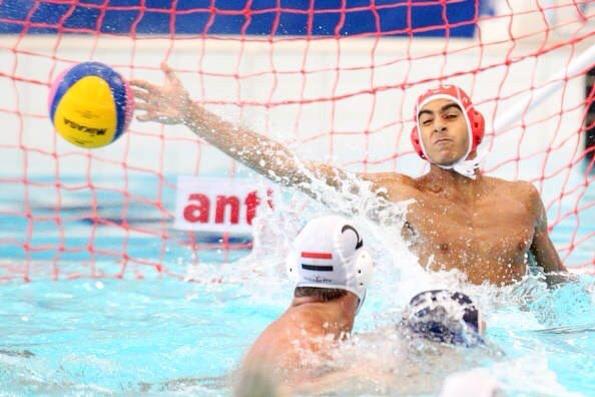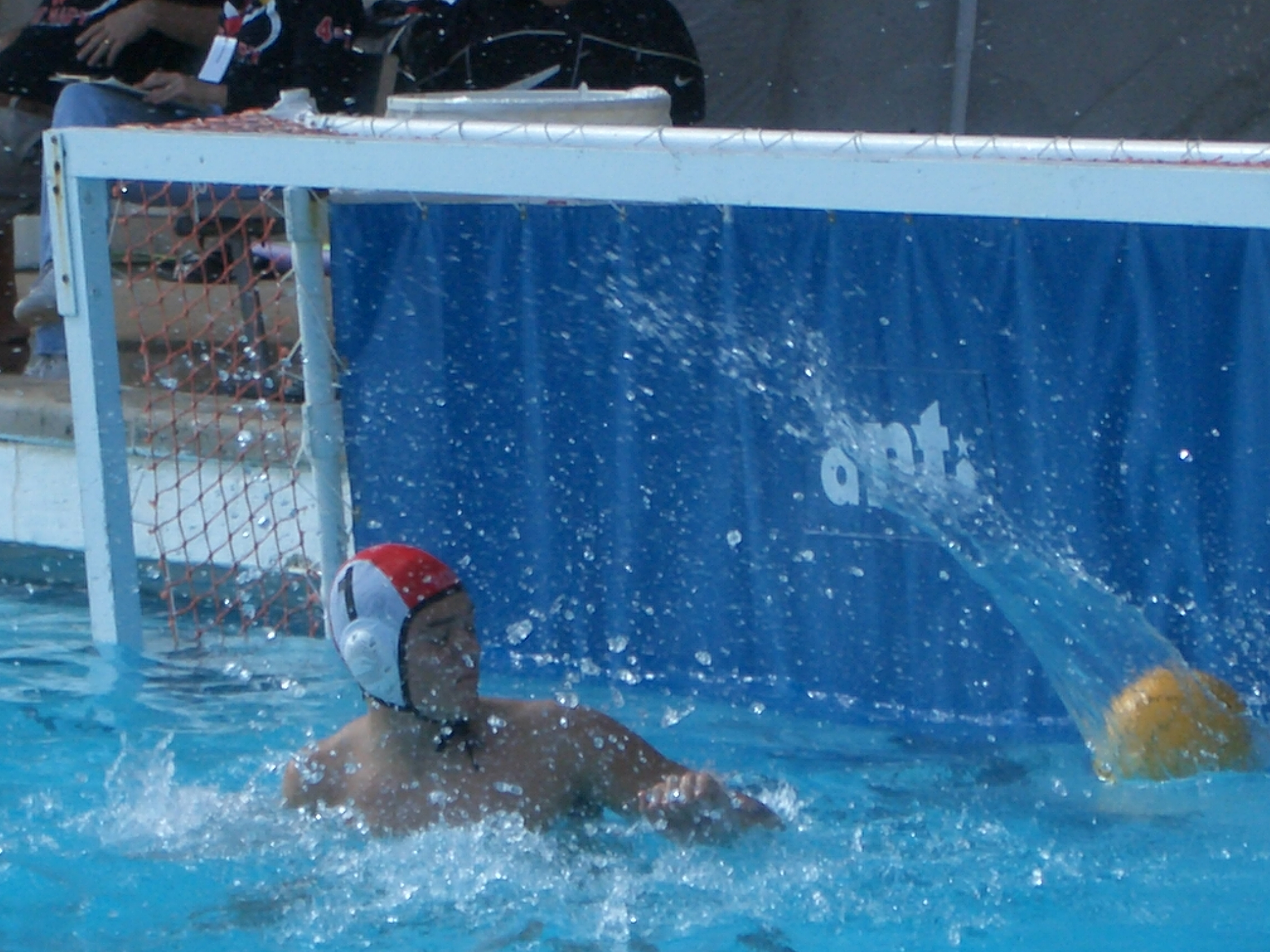 In
In History
 The position of the goalkeeper has existed since the game of water polo originated. At that time, the object of the game was to touch the ball on the opponent's end of the pool.
The position of the goalkeeper has existed since the game of water polo originated. At that time, the object of the game was to touch the ball on the opponent's end of the pool./ref> The basic functions of the goalie position have changed little over the last century, but there have been changes affecting the style of play. In the 1940s, Hungary men's national water polo team, Hungary introduced a new technique called the eggbeater kick that enables goalkeepers to maintain a stable balance in the water.
Rules Fina Rules 2019/2021 Rule variations Responsibilities and techniques Responsibilities Body part techniques Body part work Blocking techniques Notes References Bibliography Filmography
Inside the area, the goalkeeper is the only person on the team permitted to touch the ball with two hands, touch the bottom of the pool and punch the ball with a clenched fist. Although the goalkeeper may not advance beyond the half-way line, they may attempt shots at the other goal.
Any goalkeeper who makes an aggressive foul on an attacker in within the area of the goalie's team is charged with a penalty shot for the other team. The goalkeeper can also be temporarily ejected from the game for twenty seconds if they make an ordinary foul within the goalie's area(for example, by splashing). if the goalkeeper then holds the ball under the water when challenged by an opponent; it is awarded a penalty to the opponent team. A penalty is also awarded to the other team to pull down or otherwise displace the goal at anytime during the match.
Goalkeepers caps are usually numbered 1 or 13 and sometimes 15 and red colored to distinguish their position.
 In water polo, field players possess entirely different skills and responsibilities to the goalkeeper.
In water polo, field players possess entirely different skills and responsibilities to the goalkeeper.
The Goalkeeper: Part 1
. Exerted from ''WATER POLO: Learning and Teaching the Basics'' After saving the ball, the goalkeeper has the responsibility to keep possession of the ball in order to stop opposing players regaining possession. The goalkeeper is the only player who may block a penalty and because 63.7% of penalties are goals, the goalkeeper has a massive role in this area but failure to be in the correct position at a penalty is an exclusion foul. At a penalty shootout, the goalkeeper's job is critical and will largely determine the outcome of the match. If the goalkeeper is excluded during the course of the penalty shootout, then one of the other five players in the pool may take their place. The goalkeeper's hips should be high at a penalty shot to give them extra height. The goalkeeper should do one of two things at a penalty shot:
# Stay in the middle of the goal, raise themself up high and spread arms wide to eliminate the possibility of shots towards the centre of the goal
# Move to one side of the goal as a guess to where the shooter will place the ball.
Moreover, goalkeepers should have leadership. They should inform field players of information, such as unmarked players and the time of the game clock and give instructions to the field players.
The goalkeeper is the only player who may block a penalty and because 63.7% of penalties are goals, the goalkeeper has a massive role in this area but failure to be in the correct position at a penalty is an exclusion foul. At a penalty shootout, the goalkeeper's job is critical and will largely determine the outcome of the match. If the goalkeeper is excluded during the course of the penalty shootout, then one of the other five players in the pool may take their place. The goalkeeper's hips should be high at a penalty shot to give them extra height. The goalkeeper should do one of two things at a penalty shot:
# Stay in the middle of the goal, raise themself up high and spread arms wide to eliminate the possibility of shots towards the centre of the goal
# Move to one side of the goal as a guess to where the shooter will place the ball.
Moreover, goalkeepers should have leadership. They should inform field players of information, such as unmarked players and the time of the game clock and give instructions to the field players. Most of the time, goalkeepers do low-intensity work (treading water without too much effort) but when they do work (for example, when they have a man down or are in the ready position) it is very intense.
Goalkeepers must be able to perform the eggbeater kick to a high standard.
Most of the time, goalkeepers do low-intensity work (treading water without too much effort) but when they do work (for example, when they have a man down or are in the ready position) it is very intense.
Goalkeepers must be able to perform the eggbeater kick to a high standard. As blocking the ball is the primary role of the goalkeeper, they must have good knowledge of blocking techniques.
As the goalkeeper has the choice of how many hands they want to use, the decision should be made of what they want to do. A shot should be stopped with two hands either if it is weak or close to the goalkeeper's body, and normally stopped with one in other circumstances. This is because one-handed saves can go to the ball faster.
Goalkeepers should be wary of dummying, lob shots and skip or bounce shots. Dummying is where players fake shots, leading keepers to come out of the water too early. This can cause the goalkeeper to come up too early and have to go back down for energy. The lob shot is where a field player attempts to put the ball over where the goalkeeper's hands can reach. This usually happens either if the goalkeeper is out of position from the dummies or if they are too far out from the goal. The goalkeeper should swim back to try to block it, as it is nowhere near as fast as the power shot. The bounce or skip shot is where a player propels the ball at the water with enough force to make it bounce or skim along the water. It can take the goalkeeper by surprise as they cannot predict the direction the ball will go.
Most shots are saved with the arms or the hands, but goalkeepers are known to save shots with their faces and even feet.
As blocking the ball is the primary role of the goalkeeper, they must have good knowledge of blocking techniques.
As the goalkeeper has the choice of how many hands they want to use, the decision should be made of what they want to do. A shot should be stopped with two hands either if it is weak or close to the goalkeeper's body, and normally stopped with one in other circumstances. This is because one-handed saves can go to the ball faster.
Goalkeepers should be wary of dummying, lob shots and skip or bounce shots. Dummying is where players fake shots, leading keepers to come out of the water too early. This can cause the goalkeeper to come up too early and have to go back down for energy. The lob shot is where a field player attempts to put the ball over where the goalkeeper's hands can reach. This usually happens either if the goalkeeper is out of position from the dummies or if they are too far out from the goal. The goalkeeper should swim back to try to block it, as it is nowhere near as fast as the power shot. The bounce or skip shot is where a player propels the ball at the water with enough force to make it bounce or skim along the water. It can take the goalkeeper by surprise as they cannot predict the direction the ball will go.
Most shots are saved with the arms or the hands, but goalkeepers are known to save shots with their faces and even feet.
Video Sport.